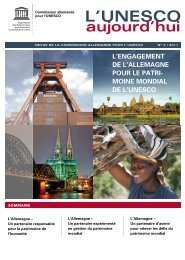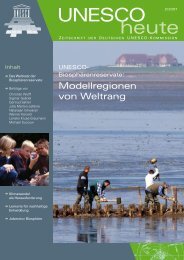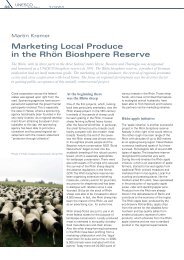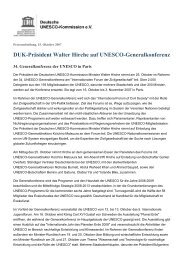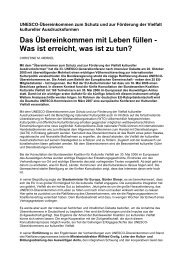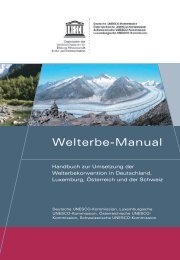Biosphere Reserves - UNESCO Deutschland
Biosphere Reserves - UNESCO Deutschland
Biosphere Reserves - UNESCO Deutschland
Create successful ePaper yourself
Turn your PDF publications into a flip-book with our unique Google optimized e-Paper software.
<strong>UNESCO</strong><br />
today 2|2007<br />
Werner Konold<br />
Dynamism and Change of<br />
Cultural Landscapes<br />
What can biosphere reserves accomplish?<br />
When developing perspectives for cultural landscapes/cultural spaces a general framework of values is<br />
needed. In that context, the question of which visionary model of the landscape is appropriate, comes<br />
up. Such a framework of values and such a vision can relate directly to the Seville Strategy of the MAB<br />
programme. <strong>Biosphere</strong> reserves are ideally suited for combining types of traditional and modern cultural<br />
landscapes as well as for further developing them in a modern approach.<br />
Photo © Werner Konold<br />
Cultural landscapes:<br />
The essence<br />
Cultural landscapes are human-modified<br />
environments; human modification or use<br />
transforms the natural landscape into a<br />
cultural landscape. Man formed nature<br />
according to his needs, what his livelihood<br />
depended on and what his creativity<br />
and technical means made possible at<br />
any one time. He had to adapt or even<br />
bow to the natural scheme of things: to<br />
the rocks, the ground, availability of water<br />
and natural nutrients, flow of waters and<br />
the altitude. Cultural landscapes have or<br />
had – apart from the specific use of the<br />
area – a specific cultural geomorphology.<br />
These are for example, walls, tree rows,<br />
waling, scarps, fences, tree-lined roads,<br />
individual trees, pits and marshes. At<br />
the same time they possess many non-<br />
functional or useless coincidences, byproducts<br />
or refuse-products resulting<br />
from human economic activity, like shrubberies,<br />
small fallows, gorges and much<br />
more. The remains of ‘natural’ nature can<br />
be found at best where cultivation was<br />
not worthwhile, where it is too wet, too<br />
steep, too dry or too stony. This assessment<br />
was, of course, always relative. The<br />
general economic conditions for establishing<br />
many elements of the cultural<br />
geomorphology, for example boulder<br />
walls, today are no longer given. These<br />
forms are, as such, relics of economic<br />
history; nevertheless they can shape<br />
the face of a landscape, even today.<br />
The traditional cultural landscape was<br />
mostly used polyculturally, i.e. there were<br />
numerous ways of use in one area. Fur-<br />
thermore there were clear use-gradients<br />
involved from the settlement down to the<br />
district boundary. There was no conservation,<br />
only movement, dynamics, progressive<br />
and regressive succession (i.e. sequences<br />
of plants and animal societies at<br />
one location), a pulsation between forest<br />
and non-forest. This dynamism had, as a<br />
whole, the effect of preserving habitats.<br />
All cultural landscapes, also those, which<br />
to us appear to be old-fashioned, were<br />
and still are subjected to dynamism, they<br />
demonstrate movement on a time axis.<br />
There were and are delayed and almost<br />
stagnating, as well as accelerated<br />
phases. These processes run differentially,<br />
in a special sense: here – batches<br />
of change, there – stagnation, perhaps<br />
under the pressure of economic distress<br />
and migration. The relationships and<br />
dependencies between the political and<br />
socio-economical framework conditions<br />
and the picture and state of the landscape<br />
have not really changed over the<br />
years. The dynamism, which is inherent<br />
to these relations, is something we<br />
have to face up to and also shape.<br />
Change in the cultural landscapes has<br />
speeded up considerably in the last<br />
decades, accompanied by a dramatic<br />
increase in developed and especially covered<br />
areas and the well-known negative<br />
effects on habitats, flora and fauna and<br />
on the geomorphology. Individual facial<br />
features of the cultural landscapes, their<br />
value and character were often obliterated<br />
or removed. Landscapes have been<br />
designed in many so-called ‘favoured<br />
areas’ in such a similar way that they ap-




